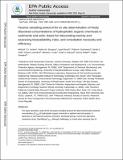| dc.contributor.author | Jonker, Michiel TO | |
| dc.contributor.author | Burgess, Robert M | |
| dc.contributor.author | Ghosh, Upal | |
| dc.contributor.author | Gschwend, Philip M | |
| dc.contributor.author | Hale, Sarah E | |
| dc.contributor.author | Lohmann, Rainer | |
| dc.contributor.author | Lydy, Michael J | |
| dc.contributor.author | Maruya, Keith A | |
| dc.contributor.author | Reible, Danny | |
| dc.contributor.author | Smedes, Foppe | |
| dc.date.accessioned | 2021-10-15T13:28:23Z | |
| dc.date.available | 2021-10-15T13:28:23Z | |
| dc.date.issued | 2020-04 | |
| dc.date.submitted | 2019-09 | |
| dc.identifier.issn | 1750-2799 | |
| dc.identifier.issn | 1754-2189 | |
| dc.identifier.uri | https://hdl.handle.net/1721.1/132973 | |
| dc.description.abstract | The freely dissolved concentration (Cfree) of hydrophobic organic chemicals in sediments and soils is considered the driver behind chemical bioavailability and, ultimately, toxic effects in benthic organisms. Therefore, quantifying Cfree, although challenging, is critical when assessing risks of contamination in field and spiked sediments and soils (e.g., when judging remediation necessity or interpreting results of toxicity assays performed for chemical safety assessments). Here, we provide a state-of-the-art passive sampling protocol for determining Cfree in sediment and soil samples. It represents an international consensus procedure, developed during a recent interlaboratory comparison study. The protocol describes the selection and preconditioning of the passive sampling polymer, critical incubation system component dimensions, equilibration and equilibrium condition confirmation, quantitative sampler extraction, quality assurance/control issues and final calculations of Cfree. The full procedure requires several weeks (depending on the sampler used) because of prolonged equilibration times. However, hands-on time, excluding chemical analysis, is approximately 3 d for a set of about 15 replicated samples. | en_US |
| dc.language.iso | en | |
| dc.publisher | Springer Science and Business Media LLC | en_US |
| dc.relation.isversionof | 10.1038/S41596-020-0311-Y | en_US |
| dc.rights | Article is made available in accordance with the publisher's policy and may be subject to US copyright law. Please refer to the publisher's site for terms of use. | en_US |
| dc.source | pmc | en_US |
| dc.title | Ex situ determination of freely dissolved concentrations of hydrophobic organic chemicals in sediments and soils: basis for interpreting toxicity and assessing bioavailability, risks and remediation necessity | en_US |
| dc.type | Article | en_US |
| dc.identifier.citation | Jonker, M.T.O., Burgess, R.M., Ghosh, U. et al. Ex situ determination of freely dissolved concentrations of hydrophobic organic chemicals in sediments and soils: basis for interpreting toxicity and assessing bioavailability, risks and remediation necessity. Nat Protoc 15, 1800–1828 (2020) © 2020, The Author(s), under exclusive licence to Springer Nature Limited. | en_US |
| dc.contributor.department | Parsons Laboratory for Environmental Science and Engineering (Massachusetts Institute of Technology) | |
| dc.contributor.department | Massachusetts Institute of Technology. Department of Civil and Environmental Engineering | |
| dc.relation.journal | Nature Protocols | en_US |
| dc.eprint.version | Author's final manuscript | en_US |
| dc.type.uri | http://purl.org/eprint/type/JournalArticle | en_US |
| eprint.status | http://purl.org/eprint/status/PeerReviewed | en_US |
| dc.date.updated | 2021-10-14T15:23:46Z | |
| dspace.orderedauthors | Jonker, MTO; Burgess, RM; Ghosh, U; Gschwend, PM; Hale, SE; Lohmann, R; Lydy, MJ; Maruya, KA; Reible, D; Smedes, F | en_US |
| dspace.date.submission | 2021-10-14T15:23:50Z | |
| mit.journal.volume | 15 | en_US |
| mit.journal.issue | 5 | en_US |
| mit.license | PUBLISHER_POLICY | |
| mit.metadata.status | Authority Work Needed | en_US |
